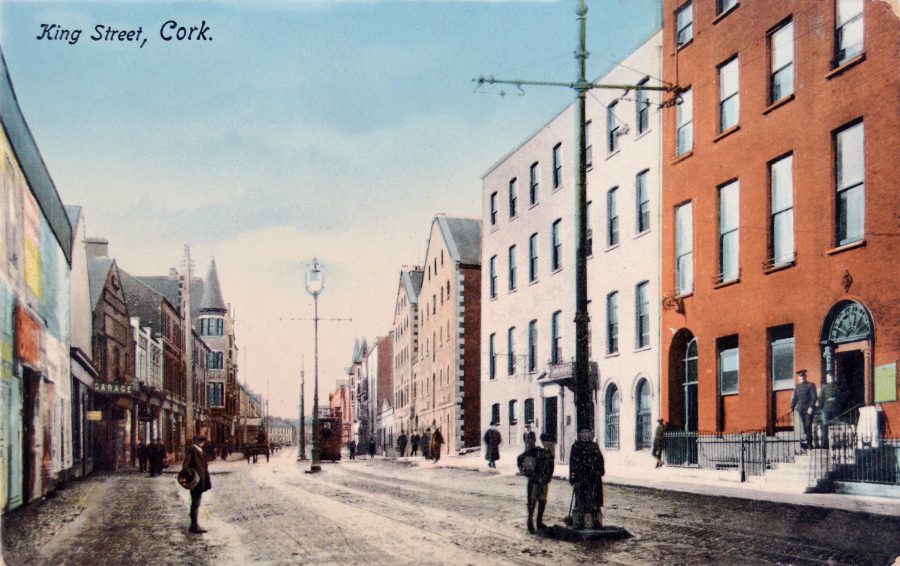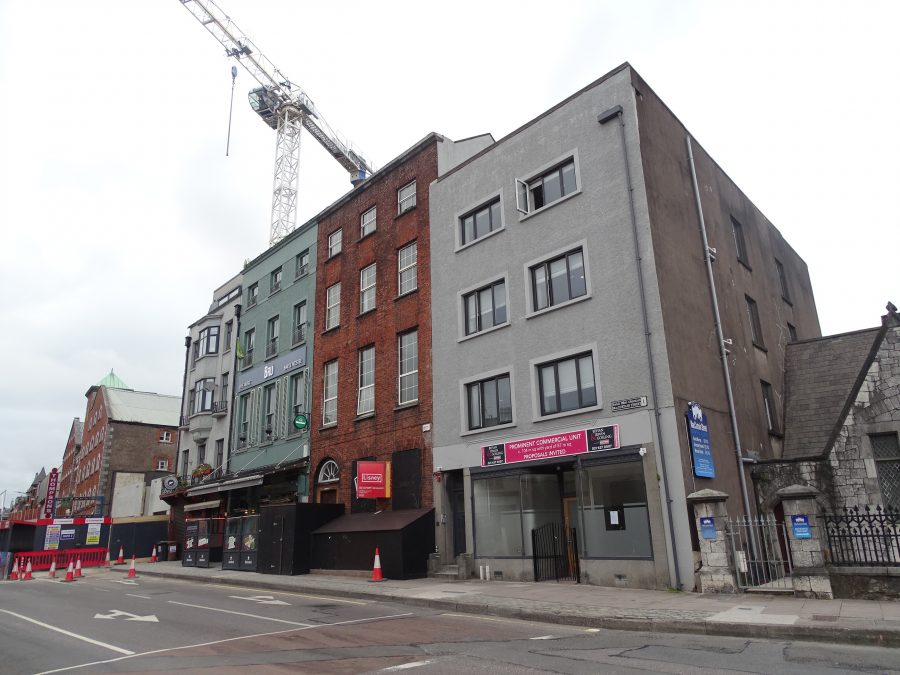
1055a. Postcard of King Street, now MacCurtain Street, with RIC Barracks shown on the right, c.1900 from Cork City Through Time by Kieran McCarthy & Dan Breen.
Kieran’s Our City, Our Town Article,
Cork Independent, 2 July 2020
Remembering 1920: Besieging MacCurtain Street Barracks
July 1920 coincided with another escalation in the ongoing War of Independence. Following successful hits on County Cork Royal Irish Constabulary (RIC) barracks, the time had come for focussed attacks on the city’s RIC barracks – led by the active 2nd Battalion of the Cork No.1 Brigade. In the broader context, Historian Dr Joost Augusteijn in the Atlas of the Irish Revolution details that by the summer of 1920, almost one third of all RIC barracks had been evacuated. By the end of 1920 a total of 553 barracks were destroyed.
Michael Murphy, Commandant of the 2nd Battalion, in his witness statement (WS1547) in the archives of the Bureau of Military History outlines several examples of activity his battalion were involved in. On 5 April 1920 Togher RIC barracks was evacuated and a short time later was burned down. On 1 June 1920 Blarney RIC barracks was burned down. On 24 June 1920, Blackrock RIC barracks, having been evacuated, was also burned by men of the 2nd Battalion.
The targeting of city centre barracks was a much riskier set of actions. Michael Murphy in his witness statement retells his side of events on the 30 June hit on the RIC Barracks on MacCurtain Street. This barracks was one of the principle stations in the city and was connected to the murder of Tomás MacCurtain some weeks previously. The street has just been renamed by Cork Corporation as well from King Street to MacCurtain Street. The barracks was occupied by a garrison of between 20 to 25 policemen as well as several Black and Tans. The barracks was quite visible but quite difficult to get close to. It was the second last of a block of five houses at the right hand side as one enters the street from Summer Hill North. The first house was the residence of Dr O’Donovan, Medical Officer of Health of Cork Corporation. Then there was the barracks, and next door above in order were the Grosvenor Hotel, Corrigan’s Hotel and the Windsor Hotel.
Michael Murphy relates in his witness statement: “To my mind, the best way to do the job was to explode a land mine from the adjoining house. I fixed the time for the explosion at about 5pm when I knew that the garrison would be inside at tea. At about 4.30pm a few of us entered the dwelling house adjoining and, having removed the occupants elsewhere, placed a large mine at the dividing wall between the house and the barracks day room. The mine was exploded and blew a large breech in the dividing wall, hurling debris into the dayroom of the barracks. This being done, I signalled to the Volunteers to withdraw, as we could not possibly hope to engage the garrison with any chance of success”.
The Cork Examiner in interviews with local people recorded that they witnessed young men in groups of two, or in some cases individually approaching everyone going along and warning them to pass quickly, “to get off the street”. Some who had made up their mind to see films thought no more of it and went into the nearby Coliseum picture house or cinema. Others obeyed the warning, and more were inclined by curiosity to loiter. It was only through warning gunshots into the air that people moved on with speed.
Stephen Foley, Lieutenant in the 1st Battalion, Cork no.1 Brigade, in his witness statement (WS1699) tells that he was told to take up position at the Coliseum Cinema for an attack on the RIC barracks, which was just across the road from that cinema. He was armed with a revolver. Other men, who were here and there across MacCurtain Street, were also armed. Michael Murphy outlines that men such as Stephen manned the whole adjacent district and were armed with revolvers. In addition, Michael relates that the vicinity of Union Quay barracks and Blackrock Road barracks was patrolled by his men – so that all bridges crossing the River Lee were similarly held by the brigade prior to the mine explosion.
The Cork Examiner records that the attack on the barracks was directed principally from Dr Donovan’s residence. Volunteers called to Dr Donovan’s house and they insisted that he should leave along with his cook and maid.It was thought that 10 lbs of gelignite were used to cause the explosion. At the time of the explosion there were ten policemen in the dayroom. As gunshots were fired up in the air outside to clear the streets, they suspected something was up and rushed to the front door and hence avoided the heart of the explosion.
The breach was nine feet by three feet in the dayroom wall with some breaking of glass in the windows. Apart from that the barracks was otherwise undamaged. The records and documents were intact. However, in Dr Donovan’s house the second floor and the hallway were absolutely destroyed, and the floor of the third storey collapsed causing the furniture to crash down onto the floors below. As the front walls had very serious cracks from the blast, it was thought that the remaining walls of Dr Donovan’s house would have to be pulled down.
Such was the force of the explosion that the walls of the Coliseum on the opposite side of the street were extensively dented with marks of stone and splinters, bits of timber being even stuck into the walls. The Coliseum filled with powder smoke and dust. The lights were still up as the exhibition of ‘pictures’ had not started. In a second the larger portion of the audience, which comprised of women and children shrieked with terror and scramble to the exits.
For fears of a sequel to the MacCurtain Street event, many citizens owning large shops in St Patrick’s Street and other thoroughfares took precautionary measures in the way of putting up temporary shuttering on their premises. Patrols were supplemented by posses of military carrying rifle bayonets. Several miniature Union Jack flags were hung from the windows of the MacCurtain Street RIC barracks and the wall of the dayroom was stuffed with sandbags.
Kieran’s new book Witness to Murder, The Inquest of Tomás MacCurtain is now available to purchase online (co-authored with John O’Mahony 2020, Irish Examiner/ www.examiner.ie).
Captions:
1055a. Postcard of King Street, now MacCurtain Street, with RIC Barracks shown on the right, c.1900 from Cork City Through Time by Kieran McCarthy & Dan Breen.
1055b. The red brick building is the former RIC Station site on MacCurtain Street (picture: Kieran McCarthy).

1055b. The red brick building is the former RIC Station site on MacCurtain Street (picture: Kieran McCarthy).